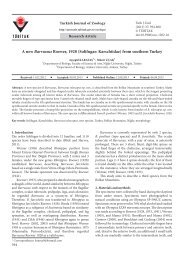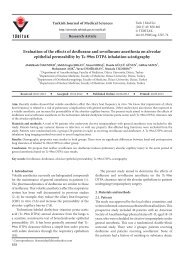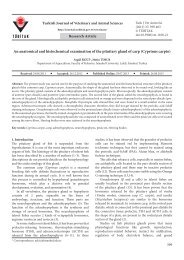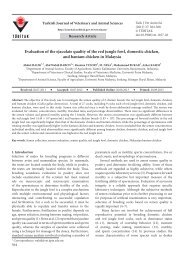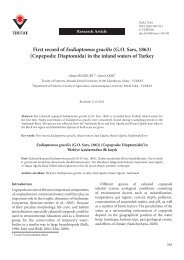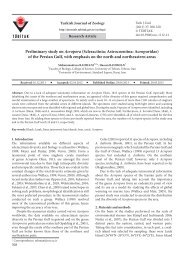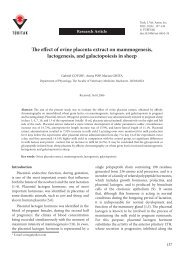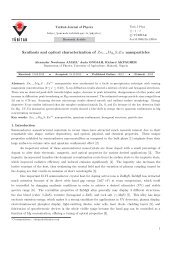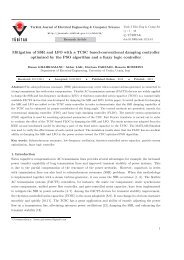Anti-inflammatory activity of Anthemis aciphylla var ... - Tübitak
Anti-inflammatory activity of Anthemis aciphylla var ... - Tübitak
Anti-inflammatory activity of Anthemis aciphylla var ... - Tübitak
Create successful ePaper yourself
Turn your PDF publications into a flip-book with our unique Google optimized e-Paper software.
<strong>Anti</strong>-<strong>inflammatory</strong> <strong>activity</strong> <strong>of</strong> <strong>Anthemis</strong> <strong>aciphylla</strong> <strong>var</strong>. <strong>aciphylla</strong> Boiss.<br />
plants belonging to this genus have been shown to<br />
possess important anti-<strong>inflammatory</strong> (13), anti-<br />
Helicobacter pylori (10), antiprotozoal (14), and<br />
antimicrobial properties (15), there have been no<br />
reports on the biological <strong>activity</strong> <strong>of</strong> A. <strong>aciphylla</strong><br />
<strong>var</strong>. <strong>aciphylla</strong> Boiss to our knowledge. The present<br />
study was therefore undertaken to evaluate the<br />
anti-<strong>inflammatory</strong> <strong>activity</strong> <strong>of</strong> the ethanolic and<br />
sesquiterpene lactone extracts <strong>of</strong> the aerial parts <strong>of</strong> A.<br />
<strong>aciphylla</strong> <strong>var</strong>. <strong>aciphylla</strong> using 2 experimental models:<br />
carrageenin-induced paw edema and cotton pelletinduced<br />
granuloma in rats.<br />
Materials and methods<br />
Plant material<br />
In May 2007, the aerial parts <strong>of</strong> <strong>Anthemis</strong> <strong>aciphylla</strong><br />
<strong>var</strong>. <strong>aciphylla</strong> (Asteraceae) were collected from İzmir-<br />
Bayındır (Alankıyı village) in western Anatolia.<br />
These samples were identified by Ö. Seçmen from<br />
the Department <strong>of</strong> Biology, Botany Section, <strong>of</strong><br />
Ege University. A voucher specimen (No: 1365)<br />
was deposited in the Herbarium <strong>of</strong> the Faculty <strong>of</strong><br />
Pharmacy at Ege University in İzmir.<br />
Chemicals<br />
The chemicals used in this study were carrageenin<br />
(Sigma), indomethacin (Deva), and thiopental<br />
sodium (Abbott).<br />
Preparation <strong>of</strong> ethanolic extract <strong>of</strong> <strong>Anthemis</strong><br />
<strong>aciphylla</strong> <strong>var</strong>. <strong>aciphylla</strong> (EEAA)<br />
The air-dried and powdered samples <strong>of</strong> <strong>Anthemis</strong><br />
<strong>aciphylla</strong> <strong>var</strong>. <strong>aciphylla</strong> (500 g) were twice extracted<br />
with ethanol (3000 mL, first for 5 h and then for 8<br />
h) under stirring. The combined organic phases were<br />
filtered and distilled in vacuo (yield 11%).<br />
Preparation <strong>of</strong> sesquiterpene lactone extract <strong>of</strong><br />
<strong>Anthemis</strong> <strong>aciphylla</strong> <strong>var</strong>. <strong>aciphylla</strong> (SEAA)<br />
The dried aerial parts <strong>of</strong> <strong>Anthemis</strong> <strong>aciphylla</strong> <strong>var</strong>.<br />
<strong>aciphylla</strong> (8.68 kg) were finely ground and extracted<br />
at room temperature with cyclohexane-Et 2<br />
O-MeOH<br />
(1:1:1). The extract was then washed with brine; the<br />
aqueous layer was subjected to extraction once again<br />
with EtOAc, and the organic layer was dried with<br />
Na 2<br />
SO 4<br />
and concentrated under reduced pressure<br />
(yield 8%).<br />
Phytochemical Analysis<br />
Preliminary phytochemical screening was carried<br />
out on the EEAA and SEAA extracts using the<br />
standard screening method described by Trease and<br />
Evans (16).<br />
Animals<br />
Female Wistar rats (Laboratory Animal Science<br />
Department, Dokuz Eylül University, İzmir, Turkey)<br />
weighing 150-200 g were used. The animals were<br />
maintained under standard laboratory conditions<br />
<strong>of</strong> humidity, temperature (24 ± 2 °C), and light (12<br />
h day:12 h night), and allowed free access to food<br />
and water ad libitum. All experimental designs and<br />
procedures received approval from the Local Animal<br />
Ethics Committee <strong>of</strong> Dokuz Eylül University.<br />
<strong>Anti</strong>-<strong>inflammatory</strong> <strong>activity</strong> in vivo models<br />
Carrageenin-induced paw edema in rats (acute<br />
model)<br />
<strong>Anti</strong>-<strong>inflammatory</strong> <strong>activity</strong> was assessed by the<br />
method described by Winter et al (17).<br />
The rats were divided into 5 groups <strong>of</strong> 6 animals<br />
each. Group I (control) was treated with a 1% aqueous<br />
solution <strong>of</strong> sodium carboxymethylcellulose (CMS)<br />
(5 mL/kg) as a vehicle. Groups II, III, and IV were<br />
treated with EEAA and SEAA extracts at dosages <strong>of</strong><br />
200, 100, and 50 mg/kg, respectively. Our final group,<br />
Group V, was treated with 4 mg/kg indomethacin<br />
as a reference. Edema was induced by a subplanter<br />
injection <strong>of</strong> 0.1 mL <strong>of</strong> 1% (w/v) carrageenin (Sigma)<br />
into the right hind paw <strong>of</strong> each rat. The volume <strong>of</strong> the<br />
injected paws was measured using a plethysmometer<br />
(Plethysmometer 7140, Ugo Basile) 1, 2, 3, 4, and<br />
5 h after the induction <strong>of</strong> inflammation. The test<br />
groups received the extract (50-200 mg/kg), the<br />
reference group received indomethacin (4 mg/kg),<br />
and the control animals received the vehicle only. All<br />
the doses were given intraperitoneally. The EEAA<br />
and SEAA extracts (200, 100, or 50 mg/kg) were<br />
given intraperitoneally 1 h prior to the injection <strong>of</strong><br />
carrageenin. The inhibitory <strong>activity</strong> was calculated<br />
according to the following formula (18):<br />
% Inhibition = (Ct – Co) control – (Ct – Co)<br />
treated/(Ct – Co) control × 100<br />
where Ct = the paw circumference at time t, Co = the<br />
paw circumference before the carrageenin injection,<br />
and Ct – Co = edema.<br />
758



